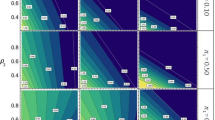Abstract
In F2 populations, gametic and zygotic selection may affect the analysis of linkage in different ways. Therefore, specific likelihood equations have to be developed for each case, including dominant and codominant markers. The asymptotic bias of the “classical” estimates are derived for each case, in order to compare them with the standard errors of the suggested estimates. We discuss the utility and the efficiency of a previous model developed for dominant markers. We show that dominant markers provide very poor information in the case of segregation distortion and, therefore, should be used with circumspection. On the other hand, the estimation of recombination fractions between codominant markers is less affected by selection than is that for dominant markers. We also discuss the analysis of linkage between dominant and codominant markers.
Similar content being viewed by others
References
Allard RW (1956) Formulas and tables to facilitate the calculation of recombination values in heredity. Hilgardia 24:235–278
Allard AW, Alder HL (1960) The effect of incomplete penetrance on the estimation of recombination values. Heredity 15:263–282
Bailey NTJ (1949) The estimation of linkage with differential viability, II and III. Heredity 3:220–228
Dempster AP, Laird NM, Rubin DB (1977) Maximum likelihood from incomplete data via the EM algorithm. J Royal Stat Soc 39:1–38
Edwards AWF (1972) Likelihood. The John Hopkins University Press, Baltimore
Fauré S, Noyer JL, Horry JP, Bakry F, Lanaud C, González de León D (1993) A molecular marker-based linkage map of diploid bananas (Musa acuminata). Theor Appl Genet 87:517–526
Fisher RA (1937) The design of experiments. Oliver and Boyd, Edinburgh London
Fisher RA, Balmukand B (1928) The estimation of linkage from the offspring of selfed heterozygotes. J Genet 20:79–92
Heun M, Gregorius HR (1987) A theoretical model for estimating linkage in F2 populations with distorted single gene segregation. Biomet J 29:397–406
Lin SY, Ikehashi H, Yanagihara S, Kawashima A (1992) Segregation distortion via male gametes in hybrids between Indica and Japonica or wide-compatibility varieties in rice (Oryza sativa). Theor Appl Genet 84:812–818
Lorieux (1993) Cartographie des marqueurs moléculaires et distorsions de ségrégation: modèles mathématiques. Thèse de Doctorat en Sciences, Université Montpellier II, France, 135 pp.
Mangin B (1991) Construction de cartes génétiques: quelques méthodes. In: Méribel 91, Méribel, France, 1–4
Pham JL, Glaszmann JC, Sano R, Barbier P, Ghesquière A, Second G (1990) Isozyme markers in rice: genetic analysis and linkage relationships. Genome 33:348–359
Wolfram S (1988) Mathematica, a system for doing mathematics by computer. Addison-Wesley Publishing Company, Inc., Redwood City, California
Wu CJ (1983) On the convergence properties of the EM algorithm. Ann Stat 11:95–103
Author information
Authors and Affiliations
Additional information
Communicated by G. Wenzel
Rights and permissions
About this article
Cite this article
Lorieux, M., Perrier, X., Goffinet, B. et al. Maximum-likelihood models for mapping genetic markers showing segregation distortion. 2. F2 populations. Theoret. Appl. Genetics 90, 81–89 (1995). https://doi.org/10.1007/BF00220999
Received:
Accepted:
Issue Date:
DOI: https://doi.org/10.1007/BF00220999




